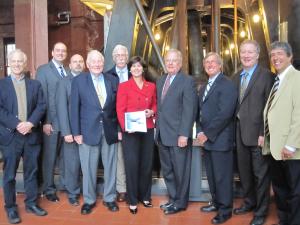
A commission charged with studying the current state of Massachusetts’s water and wastewater infrastructure systems and financing released its final report on May 9th following two years of work and numerous public hearings and meetings.
The Massachusetts Water Infrastructure Finance Commission (WIFC) found that the state faces an estimated $21.4 billion funding gap for water and wastewater infrastructure over the next 20 years, and that substantial state, federal and local investments are needed to ensure the continued availability of clean, reliable drinking water for Massachusetts homes and businesses. A copy of the report can be found Here.
“Clean water, delivered by a strong and reliable water infrastructure system, is essential for fostering ongoing economic development in the Commonwealth,” said State Senator Jamie Eldridge, who co-chaired the Commission. “Many companies rely on water to do their business, which makes a strong water infrastructure an important factor when deciding where to locate. The work of the WIFC will help ensure we have the reliable infrastructure we need to support economic growth and job creation, as well as protecting the quality of our water and streams.”
"Water is one of our most basic needs, yet we often take the infrastructure that delivers it to our homes and businesses for granted,” added co-chair Representative Carolyn Dykema. “By making investment in our water system a priority, we are also prioritizing economic growth, job creation, and the sustainability of our communities. This report highlights the work we need to do to fund and maintain this important public asset and lays out a road map for creating a 21st-century water infrastructure system to meet the needs of our Commonwealth.”
Our water infrastructure system suffers from a lack of investment, delayed maintenance, and insufficient resources, noted the report. Hundreds of miles of pipes are kept in service far past their useful life, leading to lost water, sewage leaks and, in the worst case, water main breaks. Our failure to maintain and upgrade our existing infrastructure threatens our ability to deliver reliable clean water and keep wastes and toxic chemicals out of our environment without service interruptions.
The Commission determined that a significant increase in spending, along with improved management to find efficiencies and cost savings, is needed to reduce the water and wastewater infrastructure gap currently facing the Commonwealth.
The WIFC final report lays out a number of strategies that state and local governments can use to achieve these goals, including:
- Sustaining current investments in Water and Sewer State Revolving Funds
- Establishing a Trust Fund, to be funded annually at $200 million, for a mixed program of direct payments to cities and towns, low interest loans, and grants
- Incenting all communities, authorities and districts to utilize rate structures that reflect the full cost of water supply and treatment
- Promoting best management practices to reduce costs and find efficiencies
- Assisting municipalities, districts and authorities in retiring the existing debt through a newly structured debt assistance program (to be funded at $50 - $60 million annually).
- Promoting environmental sustainability and innovation
The WIFC found that water utilities are currently facing many cost challenges, including aging systems in need of investments, improvements or upgrades required to meet stronger environmental or public health standards, necessary security and redundancy investments, rising energy and labor costs, and growing municipal debt burdens.
At the same time, water infrastructure revenues are not keeping pace with needs, as federal and state funding sources have steadily decreased. Unlike other utilities, municipal water and sewer rates often do not come close to covering the full cost of providing clean water and eliminating waste.
The result of the increasing cost challenges and the decreasing revenue is the water infrastructure gap, estimated by the Commission to be $10.2 billion in resources for drinking water and $11.2 billion in resources for wastewater projects over the next 20 years. These estimates include capital investment, repair and replacement, operations, maintenance and debt services, but do not include the cost of evolving regulatory requirements or investments to accommodate economic growth. As such, the estimates are more likely to understate rather than overstate the gap and the funding need.
More information about the WIFC and a copy of the report can be found















